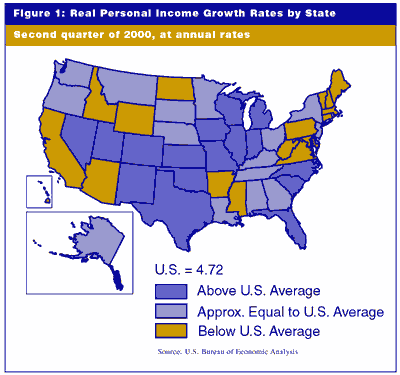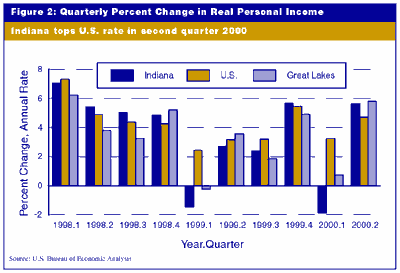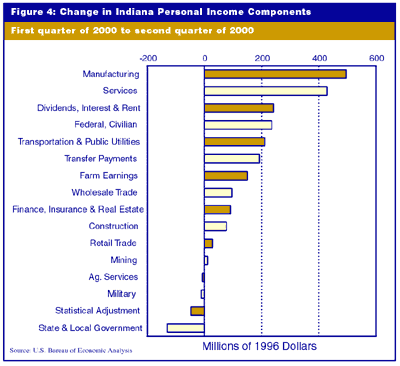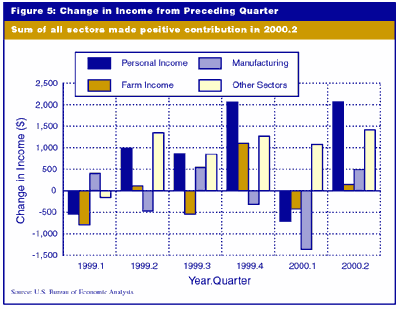Personal Income Growth Strong in Second Quarter 2000
Indiana's real personal income grew in the second quarter of 2000 at a 5.6% annual rate, which was 14th in the nation. The United States as a whole advanced by 4.7% (see Figure 1).
Click on map below to see larger version with data.

The Great Lakes states of Michigan, Wisconsin and Illinois were also national leaders, while Ohio and Kentucky trailed Indiana.
As shown in Figure 2, real personal income growth rates have not been very stable of late. In the first quarter of 2000, Indiana and 19 other states had a decline in real personal income, although the nation experienced a 3.2% increase. A similar occurrence can be found in the first quarter of 1999, but not in the first quarter of 1998, a year when Indiana led the nation most of the year.

These first-quarter declines in Indiana are particularly noteworthy because in the immediately preceding quarters—the closing quarters of 1998 and 1999—Indiana outgrew both the nation and the region. What is the cause of these variations in income growth?
Often the variability of farm income is listed as the cause of changes in Indiana personal income. That farm income is highly variable can be seen easily in Figure 3, where the bars show the real value (at annual rates) of farm income by quarter.

In the first quarter of 1998, farm income in Indiana fell by 55%, then remained steady, and then jumped in the last quarter of the year before plummeting again in the first quarter of 1999. Much of that instability is due to the irregularities of federal farm subsidies.
But it is difficult for the farm sector to be the sole factor in Indiana's personal income fluctuations. As the line (using the right-hand scale) in Figure 3 shows, farm income in this period (1997 through the midpoint of 2000) has not exceeded eight-tenths of one percent of the state's total income. Simply put, there are not enough peanuts here to power the elephant.
The best way to see what is contributing to change is the change itself. In Figure 4, the contribution to the change in 2000.2 in total personal income is shown for each component. Manufacturing contributed $495 million (at an annual rate) to Indiana's $2.1 billion income advance. This was 24% of the total gain—the result of a 1.67% increase in manufacturing earnings on a base that accounted for 20% of total income in the first quarter of the year. The amount of the contribution is determined not only by the rate of growth, but by the initial share of the total.

Hence, farming, despite its dramatic 41% gain in the second quarter, added only $149 million (7.2%) to the total change because its base was less than 1% of that total. However, the second quarter of 2000 was unlike any other quarter since the start of 1999. It was the only quarter when farming, manufacturing and the sum of all other sectors made positive contributions to the change in the state's real personal income (see Figure 5).

Both farming and manufacturing have had three down quarters in the past year and a half. The dramatic swings in these sectors give the state high variability in its personal income. When both sectors were in decline (as in the first quarter of 2000), the growth of other sectors was not sufficient to offset the downward force of farming and manufacturing. When both were advancing, Indiana was among the leaders in national growth
